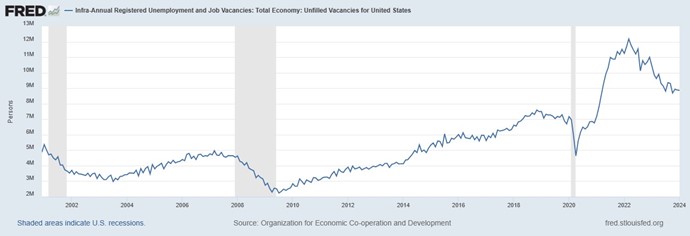While the week finished close to flat, it was not a straight line to get here. Anxiety over the US Fed’s rate announcement, earnings, and the usual raft of economic releases kept traders second guessing themselves. On the positive side, both interest rates and the price of oil subsided a bit bringing some relief to borrowers and drivers.
| Index | Close Apr. 25th 2024 | Close May 2nd 2024 |
| S&P500 | 5,096 | 5,069 |
| TSX60 | 21,885 | 21,885 |
| Canada 10 yr. Bond Yield | 3.90% | 3.77% |
| US 10 yr. Treasury Yield | 4.71% | 4.58% |
| USD/CAD | $1.36638 | $1.36718 |
| Brent Crude | $89.19 | $83.82 |
| Gold | $2,332 | $2,304 |
| Bitcoin | $64,949 | $59,097 |
Source: Trading Economics & S&P Cap IQ
We will, of course, start with this week’s rate decision by the US Federal Reserve. Unsurprisingly, the Fed decided to hold rates steady. They also downplayed the prospects of a rate cut anytime soon but at the same time said that another rate hike was unlikely. They did reduce the pace of shrinking their balance sheet (quantitative tightening or QT). Prior to this week they had ben allowing $95 billion a month to roll off through maturities or redemptions. They have dropped the cap to $50 billion per month. The Fed has shrunk their balance sheet by $1.25 trillion since the peak in 2022.
One of the wonders of the US economy has been its very tight labour market. That showed some signs of softening with this week’s “Job Openings and Labour Turnover Survey “(JOLTS). Job openings fell by 325,000 to 8.488 million in March. Unsurprisingly the number of people quitting their jobs dropped by 198,000 to 3.329 million while layoffs decreased by 155,000 to 1.526 million. While the number of job openings has dropped significantly from its high of 12,182,000 in 2022 it is still a long way from its normal range as the chart below illustrates.

The Bank of Canada (BOC) was feeling a bit more dovish than the Fed this week. In testimony before the House of Commons Finance Committee, BOC Governor Tiff Macklem said our rates do not need to match those in the US, but they do need to stay within a certain range. Macklem said the Bank was seeing the right trends but wants to see then sustained for longer. A June/July cut is not off the table here. March’s inflation rate was 2.9% vs. 3.5% in the US.
While the Federal and Ontario governments have been making big bets on EVs and battery technology, the oil & gas sector has been putting their money and efforts into carbon capture and storage (CCS). To be fair, there are federal programs and grants available for CCS technology as well. This week, CCS got knocked back a bit with power utility Capital Power abandoning its $2.4 billion Genesee CCS project. The company said the project was technically viable but not economically feasible. They did not rule out returning to the project if the economics change.
Money Laundering has been the scourge of law enforcement agencies and security services for well over a century. The financial sector has been held to increasingly stringent standards since 2001. (9/11 changed regulations in the financial sector drastically). We are now learning that one of our leading Canadian banks may not have been living up to its obligations under US anti-money laundering (AML) regulations. TD has been hit with a $9.2 million fine by Canadian regulators (FINTRAC) and has had to take a $450 million provision in relation to a US regulatory AML inquiry.
In other news, that confirms I am old, Posh Spice, aka Victoria Beckham, turned 50 recently. There are rumours that the 5 piece “girl band” is planning a re-union so on that note, we’ll stop right here and listen to this blast from the past….
Russ Lazaruk, RIAC, CIWM, CIM, FCSI
Managing Director & Portfolio Manager
![]()
